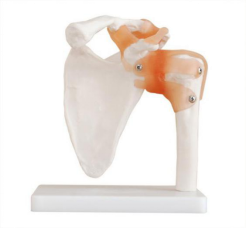06-06-2024
ADA MED SUPPLY LIMITED
Article tag: Shoulder joint model medical joint model
The shoulder joint model simulates the movement of the shoulder joint, and through its unique design and structure, it can restore the complex movement mode of the human shoulder joint as much as possible. Here is a detailed explanation of how the shoulder joint model simulates shoulder joint movement:

Joint composition simulation:
The shoulder joint model usually includes sternoclavicular joint, acromioclavicular joint, scapulothoracic wall joint and glenohumeral joint. These joints mimic the connections between different bones in a real shoulder joint, such as the clavicle, scapula and humerus.
Freedom simulation:
The shoulder joint is a joint with many degrees of freedom and can move in multiple directions. The model simulates these degrees of freedom with bendable and rotatable joint joints that allow the user to perform abduction/adduction, flexion/extension, and inrotation/outrotation.
Muscle and ligament simulation:
The movement of the shoulder joint not only depends on the bone structure, but also is pulled by the muscles and ligaments. In the shoulder joint model, the role of these muscles and ligaments is usually simulated with structures such as springs, strings or elastic bands, so as to more realistically simulate the movement of the shoulder joint.
Range of motion simulation:
The shoulder joint is one of the joints with the largest range of motion in the human body. The model simulates the motion range of shoulder joint in different directions by adjusting the restrictions of joint joints, such as abduction up to 180 degrees and forward bending up to 120 degrees.
Scapular movement simulation:
The scapula plays an important role in the movement of the shoulder joint. The model shows the complex changes of the scapula in the motion of shoulder joint by simulating the movements of the scapula, such as turning up, turning down, leaning forward and leaning back.
Dynamic presentation:
Some advanced shoulder joint models are also equipped with dynamic demonstration features, such as a motor drive to simulate the active motion of the shoulder joint, or a sensor to detect the user's actions and feed them back into the model in real time.
Material selection and manufacturing accuracy:
The material selection, manufacturing precision and assembly process of the model will also affect the simulation effect. High-quality materials and precision manufacturing can more accurately simulate the motion characteristics and details of the shoulder joint.
In summary, the shoulder joint model simulates the complex motion pattern of human shoulder joint through its unique design and structure. These models are not only helpful for medical teaching and scientific research, but also can provide strong support for rehabilitation treatment and sports training.